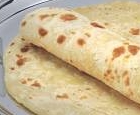|
Caribbean Side Trinidad Flat Bread Roti (from India) is found throughout the Caribbean. It's used both as a bread and a roll for meat and vegetable filling, like a soft taco. Frankly? I'd head to an ethnic food store...this is a lot of work.
In a large bowl, sift first 3 ingredients together. Combine water and oil, mixing with a whisk. Keep adding the oil-water to flour, working with your hands, to form a dough. Knead for 5 minutes till smooth. Divide into 6 or 8 balls, cover with a damp cloth, and let rest for an hour. Sprinkle flour on counter and on rolling pin; roll each ball into an 8" circle, if you're making 6 (or a 6" circle if you're making 8). Brush each circle with oil, roll back into a ball and let rest for another 20 minutes. Unroll balls and flatten into the circles again. Brush top side with oil. Using medium flame, heat a heavy skillet (without oil), and place a roti, oiled side down, into the skillet. Cook for 2 minutes, and brush the top side. Flip roti and cook for 1-2 more minutes. Add more oil if necessary, and continue flipping until you see golden spots. The bread is done. Remove to a plate and keep the rotis warm as you finish cooking the others. Serve as a bread accompaniment to any meal or spread with filling and roll. Phew. |
Tips & Glossary Caribbean cuisine is an exquisite blend of African, Asian, European, and Carib Indian (the area's original inhabitants) foods. Dishes are highly seasoned, either with a dry rub or marinade —or both. Below are some typical ingredients found in Caribbean food. Callaloo: young leaves of either the taro root plant or amaranth used widely in Caribbean cooking. Spinach can be used as a substitute. Spices: Allspice, bay leaves, black pepper, chives, chili peppers, cilantro, cinnamon, coconut, curry powder, escallion, garlic, ginger, lime, mace, nutmeg, onion, oregano, sugar, thyme, orange, tomato paste, vanilla, cayenne (red) pepper. Jerk: Jamaican cooking method in which meat is rubbed, prior to grilling, with a blend of seasonings, often firey hot. • 1 T each—onion powder, garlic powder, dried chives, brown sugar; 2 tsp. each— (ground) allspice, nutmeg, cinnamon; 1 tsp. each—sage. thyme, salt, black pepper, cayenne (or more to taste). Mix thoroughly and store in a tightly covered jar. There are thousands of versions; figure out what flavors you like most and add or subtract accordingly. Typical meats: goat, pork, chicken, and some beef (though beef has tended to be expensive). Fish: varieties that abound in surrounding waters, some familiar to us—grouper, cod, tilapia, blue marlin; others not so—200 species of jack, chip-chips (tiny clams), casadura (primitive armored catfish). Native plant foods: More familiar foods:
|
Site by BOOM
![]()
LitLovers © 2024

